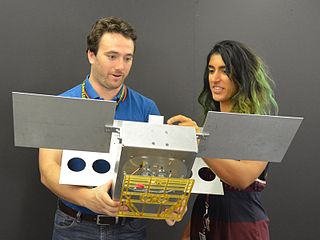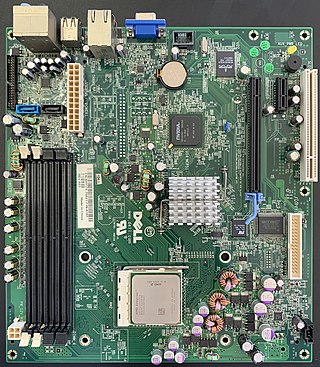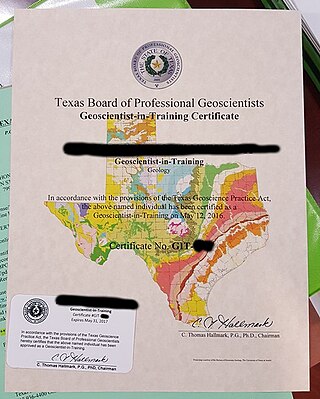Related Research Articles
Software engineering is an engineering-based approach to software development. A software engineer is a person who applies the engineering design process to design, develop, test, maintain, and evaluate computer software. The term programmer is sometimes used as a synonym, but may emphasize software implementation over design and can also lack connotations of engineering education or skills.

Engineers, as practitioners of engineering, are professionals who invent, design, analyze, build and test machines, complex systems, structures, gadgets and materials to fulfill functional objectives and requirements while considering the limitations imposed by practicality, regulation, safety and cost. The word engineer is derived from the Latin words ingeniare and ingenium ("cleverness"). The foundational qualifications of a licensed professional engineer typically include a four-year bachelor's degree in an engineering discipline, or in some jurisdictions, a master's degree in an engineering discipline plus four to six years of peer-reviewed professional practice and passage of engineering board examinations.

Computer engineering is a branch of computer science and electronic engineering that integrates several fields of computer science and electronic engineering required to develop computer hardware and software. Computer engineering is referred to as computer science and engineering at some universities.

Certified Public Accountant (CPA) is the title of qualified accountants in numerous countries in the English-speaking world. It is generally equivalent to the title of chartered accountant in other English-speaking countries. In the United States, the CPA is a license to provide accounting services to the public. It is awarded by each of the 50 states for practice in that state. Additionally, all states except Hawaii have passed mobility laws to allow CPAs from other states to practice in their state. State licensing requirements vary, but the minimum standard requirements include passing the Uniform Certified Public Accountant Examination, 150 semester units of college education, and one year of accounting-related experience.

Admission to the bar in the United States is the granting of permission by a particular court system to a lawyer to practice law in the jurisdiction. Each U.S. state and jurisdiction has its own court system and sets its own rules and standards for bar admission. In most cases, a person is admitted or called to the bar of the highest court in the jurisdiction and is thereby authorized to practice law in the jurisdiction. Federal courts, although often overlapping in admission standards with states, set their own requirements.
Regulation and licensure in engineering is established by various jurisdictions of the world to encourage life, public welfare, safety, well-being, then environment and other interests of the general public and to define the licensure process through which an engineer becomes licensed to practice engineering and to provide professional services and products to the public.
A Bachelor of Engineering or Bachelor of Science in Engineering (BSE) is an undergraduate academic degree awarded to a college graduate majoring in an engineering discipline at a higher education institution.
Computer ethics is a part of practical philosophy concerned with how computing professionals should make decisions regarding professional and social conduct.
The American Institute of Certified Planners (AICP) is the American Planning Association's professional institute. AICP certifies professionals in the United States in the field of town planning and assists planners in the areas of ethics, professional development, planning education, and the standards of planning practice. Members of AICP pledge to adhere to a detailed Code of Ethics and Professional Conduct. Once certified, professional planners may place the designation "AICP" after their name to indicate their membership in AICP, and their mastery of the principles, skills, knowledge, and experience determined by the organization as essential for a professional planner.
The Certified Financial Planner certification is a professional certification mark for financial planners conferred by the Certified Financial Planner Board of Standards in the United States, and by 25 other organizations affiliated with Financial Planning Standards Board (FPSB), the owner of the CFP mark outside of the United States. The certification is generally considered the gold standard in the financial planning industry. The certification is managed by the Certified Financial Planner Board of Standards, Inc., which was founded in 1985 as a 501(c)(3) non-profit organization; it is neither a government designation nor an accredited degree.
Certified Software Development Professional (CSDP) is a vendor-neutral professional certification in software engineering developed by the IEEE Computer Society for experienced software engineering professionals. This certification was offered globally since 2001 through Dec. 2014.
Engineering ethics is the field of system of moral principles that apply to the practice of engineering. The field examines and sets the obligations by engineers to society, to their clients, and to the profession. As a scholarly discipline, it is closely related to subjects such as the philosophy of science, the philosophy of engineering, and the ethics of technology.

The Association of Professional Engineers and Geoscientists of Alberta (APEGA) is an engineering society that regulates the practices of professional engineering and geoscience in Alberta.
Certified engineering technologist (CET) is a Canadian professional certification awarded on the basis of academic qualification and work experience. Abbreviated as C.E.T., most Canadian provincial engineering and applied science technology associations offer this certification. Certification is voluntary and does not represent a provincial regulatory requirement or a statutory required license.

Electrical/Electronics engineering technology (EET) is an engineering technology field that implements and applies the principles of electrical engineering. Like electrical engineering, EET deals with the "design, application, installation, manufacturing, operation or maintenance of electrical/electronic(s) systems." However, EET is a specialized discipline that has more focus on application, theory, and applied design, and implementation, while electrical engineering may focus more of a generalized emphasis on theory and conceptual design. Electrical/Electronic engineering technology is the largest branch of engineering technology and includes a diverse range of sub-disciplines, such as applied design, electronics, embedded systems, control systems, instrumentation, telecommunications, and power systems.

Engineering education is the activity of teaching knowledge and principles to the professional practice of engineering. It includes an initial education, and any advanced education and specializations that follow. Engineering education is typically accompanied by additional postgraduate examinations and supervised training as the requirements for a professional engineering license. The length of education, and training to qualify as a basic professional engineer, is typically five years, with 15–20 years for an engineer who takes responsibility for major projects.
Engineer in training, or EIT, is a professional designation from the National Council of Examiners for Engineering and Surveying (NCEES) used in the United States to designate a person certified by the state as having completed two requirements:
A professional technologist (P.Tech) is a class of certification of engineering technologist and professional technologist in Canada and Malaysia respectively.
This article gives an overview of professional ethics as applied to computer programming and software development, in particular the ethical guidelines that developers are expected to follow and apply when writing programming code, and when they are part of a programmer-customer or employee-employer relationship. These rules shape and differentiate good practices and attitudes from the wrong ones when creating software or when making decisions on a crucial or delicate issue regarding a programming project. They are also the basis for ethical decision-making skills in the conduct of professional work.

Geoscientist in Training, or GIT is a professional designation from the National Association of State Boards of Geology (ASBOG) and other organizations, used in U.S. States which regulate the practice of Geology and related earth science fields.
References
- ↑ "Software Engineering".
- ↑ "Program accreditation | Engineers Australia".
- 1 2 A Summary of the ACM Position on Software Engineering as a Licensed Engineering Profession (PDF), July 17, 2000
- ↑ "Software Engineering". Archived from the original on 2008-06-25. Retrieved 2008-07-30.
- ↑ "Accreditation of Software Engineering Programs is Good News". www.engineerscanada.ca. Archived from the original on 2008-01-30.
- ↑ "Software Engineering | Canada's Association of Information Technology Professionals". www.cips.ca. Archived from the original on 2011-07-15.
- ↑ "Archived copy". Archived from the original on 2019-03-28. Retrieved 2016-03-31.
{{cite web}}: CS1 maint: archived copy as title (link) - ↑ APEGBC
- ↑ Institute for Certification of Computing Professionals (ICCP),
- ↑ Software Engineering Code of Ethics and Professional Practice
- ↑ Computer Society and ACM Approve Software Engineering Code of Ethics
- ↑ Association of Professional Engineers and Geoscientists of British Columbia (APEGBC)
- ↑ Association of Professional Engineers and Geoscientists of Alberta (APEGA)
- ↑ Moore, Melody M. (2003). A License to Practice Software Engineering. IEEE Software, 20(3), 112-113.
- ↑ For more information, see:
- http://se.uwaterloo.ca/~jmatlee/talks/kwsqa02.pdf
- http://www.faqs.org/faqs/engineering/pe-eit-exam/ Apr 10, 2002
- http://www.sdmagazine.com/documents/s=746/sdm0003g/0003g.htm
- ACM position on licensing of software engineers, http://www.acm.org/serving/se_policy/
- http://www.cs.virginia.edu/~jck/publications/cacm.2002.pdf-->
- ↑ U.S Department of Labor and Statistics The 2000 Standard Occupational Classification (SOC) System: 15-0000 Computer and Mathematical Occupations
- ↑ U.S Department of Labor and Statistics The 2000 Standard Occupational Classification (SOC) System: 17-0000 Architecture and Engineering Occupations
- ↑ Florida Board of Professional Engineering. "The 2019 Florida Statutes".
- ↑ PROFESSIONAL ENGINEERS AND LAND SURVEYORS. "O.C.G.A. § 43-15-1" (PDF).
- 1 2 NJ Engineering Board. "NEW JERSEY ADMINISTRATIVE CODE TITLE 13 LAW AND PUBLIC SAFETY CHAPTER 4 0" (PDF).
- 1 2 SC Engineering Law. "Code of Laws - Title 40 - Chapter 22 - Engineers and Surveyors".
- 1 2 AL Engineering Law. "Alabama Law Regulating Practice of Engineering and Land Surveying" (PDF).
- 1 2 VW Engineering Law. "West Virginia Engineering Law Statutes and Rules" (PDF).
- 1 2 OK Engineering Law. "Oklahoma Statutes, Rules and Ethics for Professional Engineers" (PDF).
- 1 2 NV Engineering Law. "NRS: Chapter 625 - Professional Engineers and Land Surveyors". Unlawful practice of engineering.
- 1 2 MS Engineering Law. "Part 901: Rules and Regulations of the Mississippi Board of Licensure for Professional Engineers and Surveyors" (PDF).
- 1 2 IL Engineering Law. "225 ILCS 325/ Professional Engineering Practice Act of 1989".
- ↑ Florida Board of Professional Engineering. "Chapter 471" (PDF).
- ↑ GEORGIA BOARD OF PROFESSIONAL ENGINEERS AND LAND SURVEYORS. "O.C.G.A. § 43-15-1" (PDF).
- ↑ "New Software Engineering Exam Approved for Licensure". IEEE Computer Society. 4 May 2012. Retrieved 6 August 2018.
- ↑ "NCEES discontinuing PE Software Engineering exam". National Council of Examiners for Engineering and Surveying. 13 March 2018. Retrieved 6 August 2018.
- ↑ 'Professional Engineers of Ontario' – "Quebec Engineers win court battle against Microsoft"
- ↑ "Professional Engineers Act". July 24, 2014.
- ↑ "Academic Requirements". www.peo.on.ca.
- ↑ "Confirmatory Exam Program". www.peo.on.ca.
- ↑ "mybtechdegree.ca". mybtechdegree.ca.
- ↑ Excerpt taken from GOV.ON.CA, See also:
- ↑ "Lög um löggildingu nokkurra starfsheita sérfræðinga í tækni- og hönnunargreinum" (in Icelandic). Parliament of Iceland – Althing. March 11, 1996. Retrieved August 25, 2014.
- ↑ "Lög um breytingu á lögum nr. 8/1996, um löggildingu nokkurra starfsheita sérfræðinga í tækni- og hönnunargreinum, með síðari breytingum". Alþingi. Retrieved 2016-10-03.
- ↑ "Good Practice Guidelines for Software Engineering in New Zealand" (PDF). IPENZ.